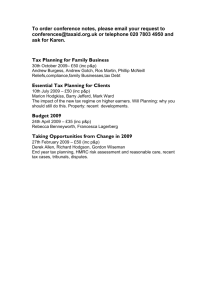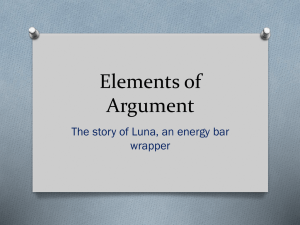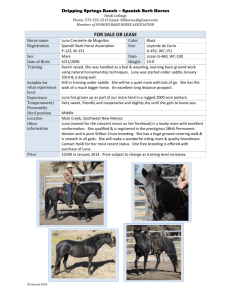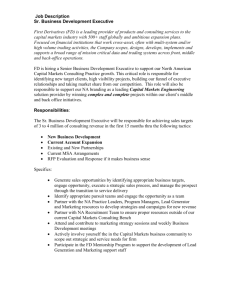Review of Measures Used In U.S. News & World Report
advertisement
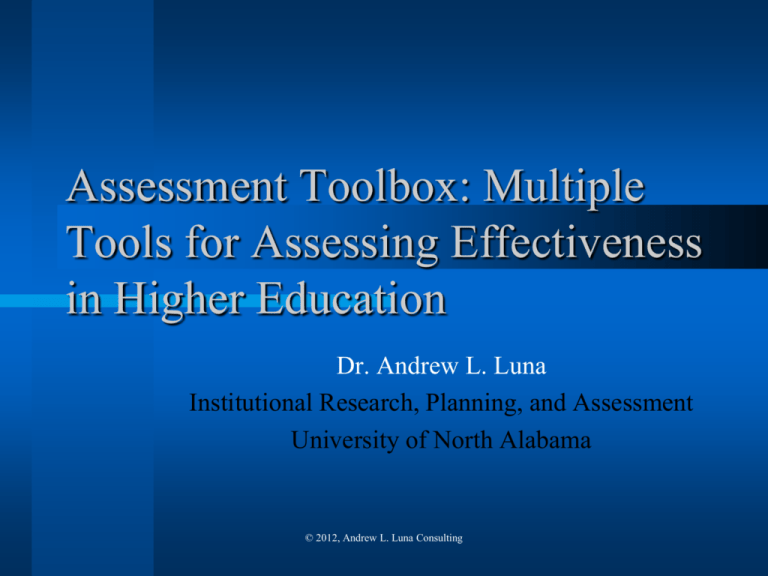
Assessment Toolbox: Multiple Tools for Assessing Effectiveness in Higher Education Dr. Andrew L. Luna Institutional Research, Planning, and Assessment University of North Alabama © 2012, Andrew L. Luna Consulting Contact Information Dr. Andrew L. Luna Director Institutional Research, Planning and Assessment University of North Alabama 256-765-4221 alluna@una.edu © 2012, Andrew L. Luna Consulting Assessment? x1 x2 t S x1 x2 © 2012, Andrew L. Luna Consulting Gosset, Beer, and Statistics… William S. Gosset (1876-1937) was a famous statistician who worked for Guiness. He was a friend and colleague of Karl Pearson and the two wrote many statistical papers together. Statistics, during that time involved very large samples, and Gosset needed something to test difference between smaller samples. © 2012, Andrew L. Luna Consulting William Gosset Sir Francis Bacon Francis Bacon (1561 –1626) was an English philosopher, statesman, lawyer, jurist, and author. Although not primarily known as a scientist, Bacon wrote a philosophical work called Novum Organum 1620. In it, he detailed a new system of logic called the Baconian method. This book was foundational to empirical thinking and inductive reasoning. Note: A statistical test called the Chi Square was later used to determine if Bacon wrote plays attributed to William Shakespeare © 2012, Andrew L. Luna Consulting Points of Discussion The origins of outcomes measures and continuous improvement What is improvement? The fact that surveys and nationally normed tests are not the only methods of successful assessment Examples of how outcomes measures are used in the improvement process within higher education Questions © 2012, Andrew L. Luna Consulting Connections to IE? © 2012, Andrew L. Luna Consulting Telephones and IE? Walter Shewhart Edwards Deming Joseph Juran Hawthorne Works, Bell Laboratories © 2012, Andrew L. Luna Consulting Shewhart Cycle Plan Act Continuous Improvement Do Check FACT... The Shewhart Cycle is the foundation for all quality and Continuous improvement processes that we use today © 2012, Andrew L. Luna Consulting More on the Shewhart Cycle Plan – Create a strategy as to what you want to do and how you will measure success Do – Follow the plan and do what you say you will do Check – Assess the effectiveness of the current plan by looking at the success outcomes measures Act – Make changes to the strategies to improve the measured outcomes Repeat the Cycle! © 2012, Andrew L. Luna Consulting Why is the Shewhart Cycle Important? If you can’t measure something, you can’t understand it… If you can’t understand it, you can’t control it… If you can’t control it, you can’t improve it… If you can’t improve it…then why the heck are you doing it? © 2012, Andrew L. Luna Consulting Shewhart Cycle and SACS Core Requirement 2.5: Planning Check and Act The institution engages in ongoing, integrated, and institution-wide research-based planning and evaluation processes that (1) incorporate a systematic review of institutional mission, goals, and outcomes; (2) result in continuing improvement in institutional quality; (3) demonstrate the institution is effectively accomplishing its mission Do © 2012, Andrew L. Luna Consulting Shewhart and SACS, Cont. Plan Comprehensive Standard 3.3.1: The institution identifies expected outcomes for its education programs … and its administrative and educational support services; assesses whether it achieves those outcomes; and provides evidence of improvement based on analysis of those results Check Do and Act © 2012, Andrew L. Luna Consulting Shewhart Modified…DMAIC Control Improve Define Measure Analyze DMAIC: Expands upon Shewhart and is the method used to improve the current capabilities of an existing process. This is by far the most commonly used methodology of continuous improvement teams. © 2012, Andrew L. Luna Consulting DMAIC Methodology Define – Identify, prioritize, and select the right project(s) Measure – Identify key outcomes measures, process parameters, and measure performance Analyze - Identify the key (causative) process determinants Improve – Establish prediction model, DOE, or other improvement tool and optimize performance Control – Hold the gains © 2012, Andrew L. Luna Consulting Outcome Focus Process Optimization Process Characterization Define The right outcome(s), the right team(s) Measure Y Analyze Improve Control Process Problems and Symptoms Process outputs Response variable, Y X’s QEP? Independent variables, Xi Process inputs The Vital Few determinants Causes Mathematical relationship © 2012, Andrew L. Luna Consulting Goal: Y = f ( x ) Inputs, Processes, and Outcomes Measurement X’s Materials X’s Methods X’s X’s Input Y’s Outcomes X’s Environment X’s People © 2012, Andrew L. Luna Consulting X’s Machines Customers: A Traditional Model High Schools, Business Students Inputs Academic, Ed. Support, Admin. Systems and Processes Employers Outputs Grad Schools Licensure Gradates Suppliers Customers Feedback Knowledge Bank Feedback In Higher Education, Students Are Pseudo-Customers © 2012, Andrew L. Luna Consulting Data and Assessment Examples All examples were taken from assessment projects within actual colleges and universities These examples (from simple to complex) show only a fraction of the assessment tools available Most of these examples require no to little statistical training © 2012, Andrew L. Luna Consulting Trend Analysis for English Quality Point Average English-100 & 200 Level Courses 3.5 3.4 3.25 3.3 3.2 3.24 3.2 3.07 3.1 3 100 level 2.91 2.9 2.8 200 level 2.94 2.94 2.88 2.84 2.92 Linear (200 level) 2.7 2.6 2.5 Fall 2003 Linear (100 level) Fall 2004 Fall 2005 Fall 2006 Fall 2007 © 2012, Andrew L. Luna Consulting Financial Aid Process Charting Bottleneck of applicationsMeasurement to be reviewed Too many mistakes by applicant Materials Methods Pick up application in box. Very little assistance Submitted Application Too few staff and too many applications Environment People © 2012, Andrew L. Luna Consulting Machines US Government Form: ‘nuff said Y = Time Completed Application Computer entry errors In-House Satisfaction Survey: Importance and Satisfaction Availability of Major National Reputation State-Wide Reputation Quality of Undergrad Ed. Cost to Attend Scholarship Availability Warm/Friendly Campus Access to Faculty Small Student/Faculty Ratio Safe Campus Selective Admissions Standards Athletic Programs Quality of Faculty Job Placement Social Events Leadership Development Honors Program Distance from Home Distance from Metro Area Quality of Facilities © 2012, Andrew L. Luna Consulting Satisfaction Survey Results: Gap Analysis Measures both the Importance and Satisfaction of a particular variable or attribute The Performance Gap is the difference between the Importance Measure and the Satisfaction Measure The higher the Performance Gap, the least institution is meeting customer expectations © 2012, Andrew L. Luna Consulting Alumni Marketing Survey Results Interpreting the Radar Chart 1 Meeting Expectations 2 6 Larger Gap Smaller Gap 5 3 4 Importance Satisfaction © 2012, Andrew L. Luna Consulting Exceeding Expectations /Possible Overkill Student Satisfaction and Radar Charts 2007 2005 Availability of Major Distance to Metro Area 7 National Reputation Distance from Home State-Wide Reputation 6 5 4 3 2 1 Honors Programs Leadership Development Social Events Quality of Undergrad. Ed. Cost to Attend Scholarship Availability Job Placement Warm/Friendly Campus Quality of Faculty Quality of Facilities Athletic Programs Selective Adm. Standards Access to Faculty Small Faculty/Student Ratio Availability of Major Distance to Metro Area National Reputation 7 Honors Programs Leadership Development Social Events State-Wide Reputation Quality of Undergrad. Ed. Cost to Attend Scholarship Availability Job Placement Warm/Friendly Campus Quality of Faculty Quality of Facilities Athletic Programs Access to Faculty Selective Adm. Standards Safe Campus Importance 6 5 4 3 2 1 Distance from Home Small Faculty/Student Ratio Safe Campus Importance Satisfaction © 2012, Andrew L. Luna Consulting Satisfaction ANOVA – Example College of Education used an evaluation questionnaire to determine the level of competence a student teacher exhibited toward required dispositions/characteristics The evaluation was completed by students, faculty members, and teachers in the classroom ANOVA was used to determine difference between the three groups © 2012, Andrew L. Luna Consulting Measurement of Differences for Teacher Education Dispositions Comparisons - Spring 2007 3 2.75 2.5 2.25 2 1.75 1.5 1.25 1 Disp 1* Disp 2 Student Faculty Disp 3 Disp 4* Disp 5*Teacher Disp 6 Note: * indicates a significant difference at < .05 © 2012, Andrew L. Luna Consulting Disp 7* Pareto Chart in Residence Halls Residential Life Incident Reports – 2 Years 250 100.00% 80% 80.00% 70.00% 60.00% Count 150 50.00% 100 40.00% 30.00% 50 20.00% 10.00% Th Ha ef t rra ss m en t M ed ic al M ec ha ni ca l Sa fe ty Al co ho Va l nd al ism n re Fi sit at io Vi No i isc M se 0.00% . 0 © 2012, Andrew L. Luna Consulting Cumlative Percentage 200 90.00% Pareto Chart with Trend Analysis Trend Analysis © 2012, Andrew L. Luna Consulting Learning Outcomes Outcome: Students completing the main sequence general chemistry CHEM1110/1120 will be able to demonstrate a thorough knowledge of general chemistry as evidenced by an average score exceeding the national average on the national ACS General Chemistry Exam. Assessment: ACS General Chemistry Form © 2012, Andrew L. Luna Consulting Historical Performance of ACS Score (Y) Historical Comparison 44 42 40 38 36 34 32 1 2 3 Institution 4 Nat. Norm © 2012, Andrew L. Luna Consulting 5 What X Variables Contribute to ACS Exam Score? SAT Math HSGPA Classroom Content Laboratory Work Homework Newly designed workshop © 2012, Andrew L. Luna Consulting Regression Analysis Run two regression analyses where final grade and the ACS scores were the Y’s Observe the relationships between the X variables and the Y’s Develop a Path Analysis to better understand both the direct and indirect relationships © 2012, Andrew L. Luna Consulting Path Analysis for Chemistry .1105 .3919 WS HSGPA GRADE .2024 SATM ACS .7675 .6665 UG .5430 © 2012, Andrew L. Luna Consulting UG Hot Water Problem in Residence Halls Survey found that most residents in a female hall were unhappy with the bathrooms Subsequent focus groups found that residents were upset over the quantity and quality of hot water Define – Hot water variability in high-rise residence hall Measure – Record temp. of hot water on high, med., and low floors for two weeks, three times a day Analyze – Plot hot water on X-Bar/R Control Chart © 2012, Andrew L. Luna Consulting Control Chart for Hot Water Hugging of the Mean Periodicity Means 140 130 120 110 100 1 2 3 4 5 6 7 8 9 10 11 12 13 14 15 16 17 18 19 2 21 2 2 2 2 2 2 2 2 3 31 3 3 3 3 3 R 3 3 4 41 Exceeding Control Limit 45 40 Trend 35 Ranges 3 30 Run 25 20 15 10 5 0 1 2 3 4 5 6 7 8 9 10 11 12 13 14 15 16 17 18 19 2 21 2 2 2 2 2 2 2 © 2012, Andrew L. Luna Consulting 2 3 31 3 3 3 3 3 3 3 3 4 41 Control Chart for Hot Water in Residence Hall, Cont. Improve – After understanding the process and the control chart, the team offered suggestions to control variability Control – A new control chart was run after changes to the system and the process was found to be in control Money – The changes decreased utility costs and increased student retention in the hall © 2012, Andrew L. Luna Consulting Regression Models A regression model was used to explain the relationship between academic departmental budget allocations and those variables that could contribute to the variance in these allocations. Bud . Alloc. x1 , x2 , x3 xi © 2012, Andrew L. Luna Consulting Simple Regression Model y Predicted Values Residuals r Y Yˆ i i i Slope Actual Values x © 2012, Andrew L. Luna Consulting Multiple Regression Model Y X1 X2 © 2012, Andrew L. Luna Consulting The First Model - Variables Number of full-time professors (dependent) Number of majors Total degrees conferred Total credit hours generated Total credit hours generated by majors Total lower-level credit hours generated Total upper-level/grad. Hours generated Delaware cost per credit hour Market value of the discipline © 2012, Andrew L. Luna Consulting Results of Selected Model F Statistic = 66.04 (.0001) R-Squared - .9497 Standard Deviation of the unexplained budget allocation (Root MSE) = $96,942 © 2012, Andrew L. Luna Consulting Parameter Estimates of Selected Model Variable Intercept Parameter Estimate Pr > |t| -544842 0.0027 PROF 43586 <.0001 CHRS 9.4536 0.1474 DEGREES -1346.6 0.2206 MARKET 842966 <.0001 CHRS*DEGREES 0.20361 0.0104 -1.48669 0.002 CHRS*PROF © 2012, Andrew L. Luna Consulting So, What Happened? The VPAA reviewed the model along with the departmental budget requests He used the model to identify those departments that were either significantly under funded or over funded VPAA made adjustments to budget allocations based in part upon the model © 2012, Andrew L. Luna Consulting Success with Assessment… A spectrum of continuous improvement tools will lead you down the road to assessment success © 2012, Andrew L. Luna Consulting Questions or Comments? Dr. Andrew L. Luna Director, Institutional Research Planning and Assessment University of North Alabama alluna@una.edu © 2012, Andrew L. Luna Consulting


